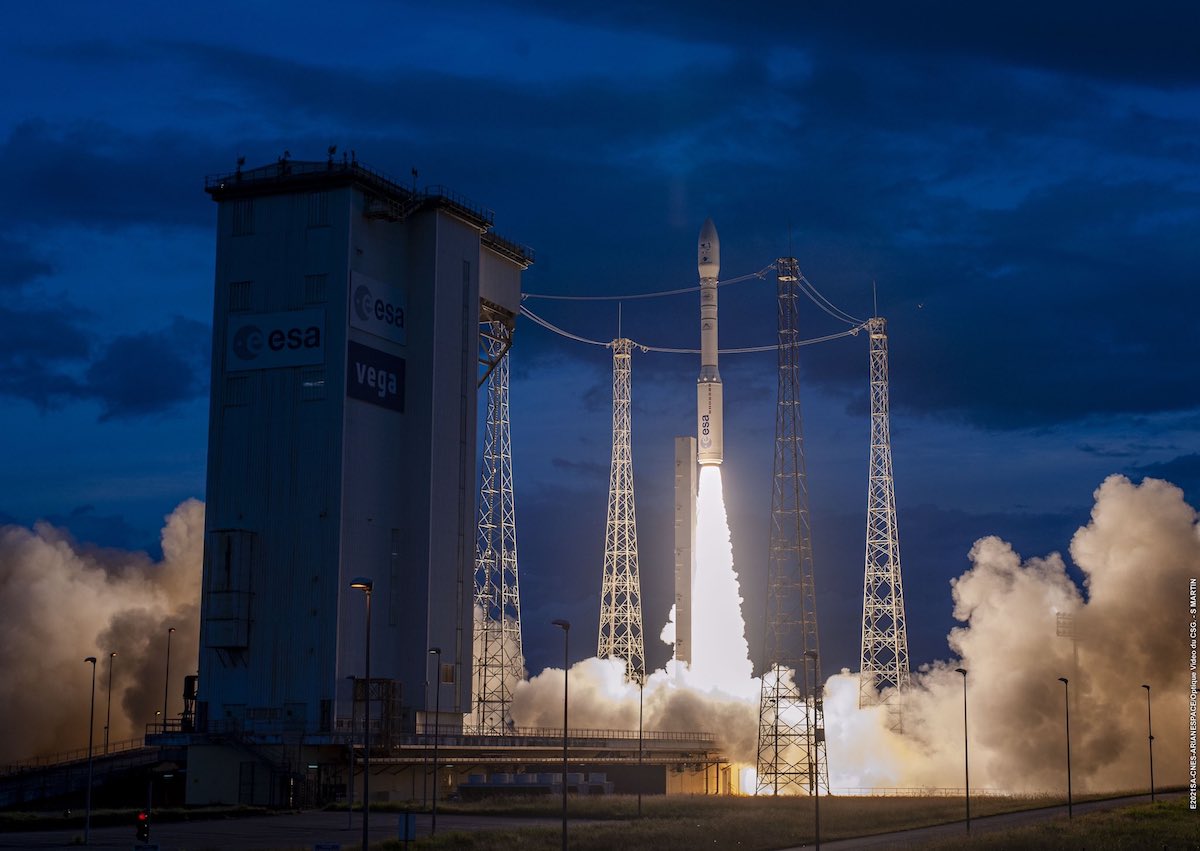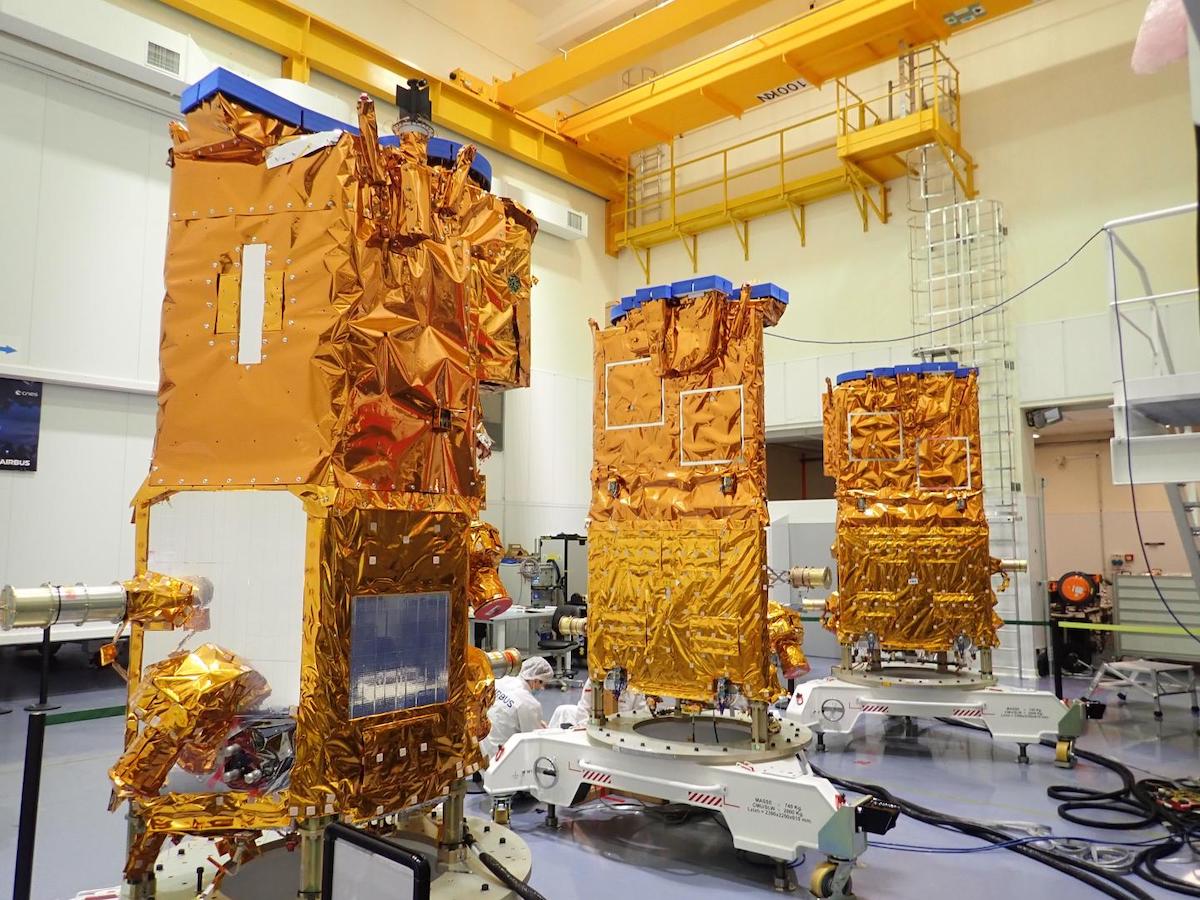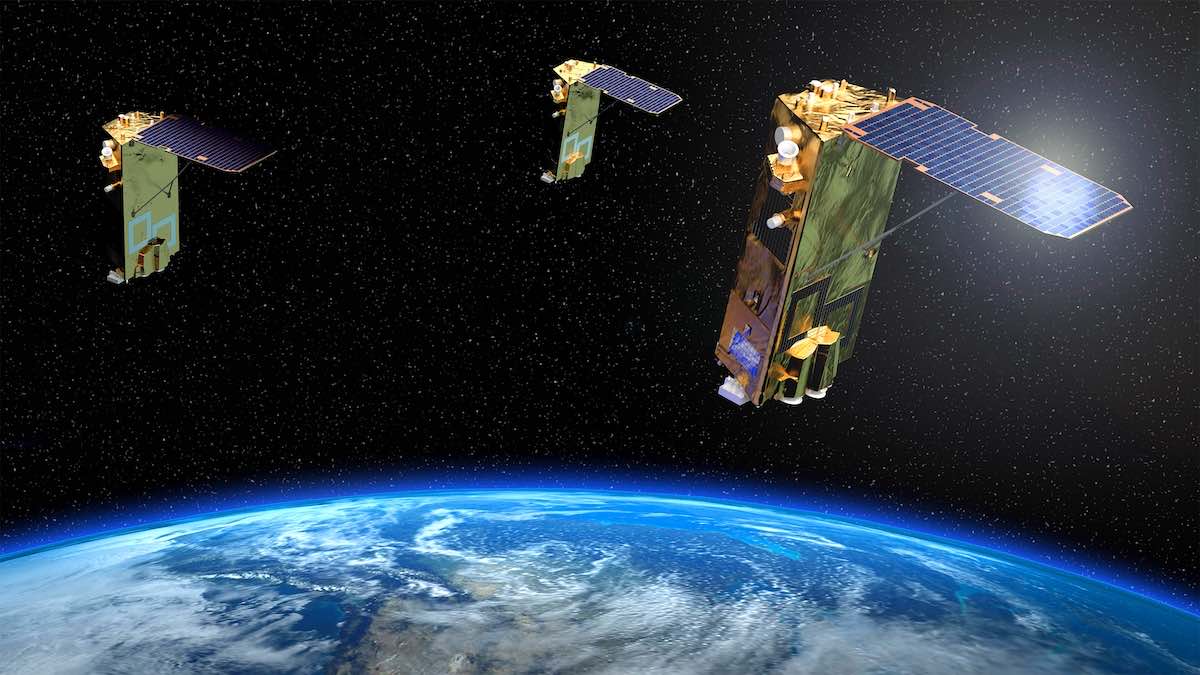
A European Vega rocket fired into space from French Guiana Tuesday and deployed three French military satellites to locate sources of radio and radar transmissions around the world, clearing the way for final modifications on the Vega launch pad for an uprated version of the booster set to debut next year.
The 98-foot-tall (30-meter) launcher ignited its solid-fueled booster stage and climbed off its launch pad at 4:27:55 a.m. EST (0927:55 GMT), rapidly rising above four lightning protection towers and heading north-northeast from the European-run spaceport on the northern coast of South America.
Liftoff occurred at 6:27 a.m. local time in French Guiana, about 10 minutes after sunset. The Vega launcher’s solid-fueled P80 first stage powered the rocket into a mostly clear sky with 683,000 pounds of thrust before burning out and jettisoning nearly two minutes into the flight.
Two more solid motors fired in succession, and the Vega’s Swiss-made payload shroud separated to fall into the Atlantic Ocean.
The rocket’s final stage, with a liquid-fueled engine, ignited two times to position the French military’s three new reconnaissance satellites into orbit. The three satellites deployed from a custom-designed dispenser nearly 57 minutes after launch.
Arianespace, the Vega rocket’s operator and launch service provider, confirmed the mission was successful in a post-launch press release. The French Ministry of Armed Forces also declared the launch a success.
Liftoff of the Vega rocket from French Guiana, boosting three CERES electronic intelligence satellites into orbit for the French military. https://t.co/tTLXxaeKMR pic.twitter.com/UEYANe4w4L
— Spaceflight Now (@SpaceflightNow) November 16, 2021
The three spacecraft will collect information on radio frequency and radar installations for the French military.
The satellites are known by the mission’s French acronym CERES, which stands for CapacitÉ de Renseignement Électromagnétique Spatiale. The CERES satellites each carry sophisticated instrumentation to detect, locate, and characterize telecommunications stations and radar sites, providing information on enemy capabilities to French military commanders.
The launch of the CERES satellites follows the deployment of the first satellite in a new generation French Syracuse military communications spacecraft last month. The Syracuse 4A satellite launched Oct. 23 from French Guiana on an Ariane 5 rocket.
“I extend my congratulations to the government and industrial teams who made this launch a success,” said Florence Parly, France’s minister of the armed forces, in a statement. “CERES is an innovative means of intelligence which contributes to the strengthening of our space defense capabilities, which are decisive for our sovereignty and our strategic independence.
“A few weeks after the successful launch of the Syracuse military satellite, France is confirming its power in the space sector, by combining technologies and resources that few countries in the world have mastered,” Parly said.
CERES is the first electromagnetic intelligence mission of its kind by a European country, giving the French military a capability previously exclusive to the United States, Russia, China, and India.
“We have the first and a unique space electromagnetic intelligence system in Europe,” said Gen. Michel Friedling, head of French Space Command. “It’s a success for us. It’s a success for our strategic autonomy because thanks to this system, we’ll be able to detect and characterizes all electromagnetic signals that would be a threat to our operations and to our capabilities. This will be done by our military intelligence services.”
The three identical CERES satellites will fly in a triangle formation, with each spacecraft independently scanning for radio emissions coming from Earth. Each spacecraft will detect the ground-based radio signals at slightly different times, just a fraction of a second apart. Analysts can work out the origin of the transmissions by comparing the time tags showing when each CERES satellite received the signals.
“This CERES system is going to be able to locate an electromagnetic radar on the surface of Earth thanks to a triangulation technique,” said Philippe Steininger, military advisor to the president of CNES, the French space agency. “Each of these satellites will receive electromagnetic waves from the ground with a small gap in time, and via triangulation, they will calculate the positioning on the earth. So the outcome of the measurement will be all the more accurate when we can maintain the formation.”

Once teams locate the source of the radar signal or radio message, the CERES satellites will help analysts and military commanders determine information about the frequency a station is using, whether a station is mobile or fixed, and the type of modulation used by the transmitter.
French military officials say the CERES satellites will not listen in on the contents of messages, but will supply valuable intelligence to French authorities about adversaries.
“The life cycle of these satellites will be about 10 years,” said Hervé Grandjean, a spokesperson for the French Ministry of Armed Forces. “There will be a next generation afterwards. But it’s an important part of France’s sovereignty that was just confirmed to enable our forces to take action without asking for anybody’s opinion or help.”
Information on an enemy radar location could help French military forces jam or eliminate the site. Conversely, radar data could help French and allied forces evade radars with their airplanes and helicopters, according to the DGA, the French military procurement agency.
The DGA manages the CERES program, which has cost France around $500 million (450 million euros) to develop and prepare for launch.
French Space Command will be in charge of collecting and disseminating data from the CERES satellites. CNES was responsible for developing the ground control center in Toulouse, providing project management support, and arranging the mission’s launch with Arianespace on a European Vega rocket.
Airbus Defense and Space is prime contractor on the CERES project, while Thales Alenia Space supplied the three spacecraft platforms.
“The Ministry of Armed Forces is is really taking a big leap ahead in terms of capabilities with this morning’s success,” Grandjean said. “We’ll be more accurate. we’ll be more autonomous. We’ll be better able to assess the military situation. It will help us in assessing the geopolitical situation of the world.”
The three CERES spacecraft will be part of the French military’s constellation of operational surveillance satellites. It builds on two previous tech demo missions — Essaim and ELISA — that launched 2004 and 2011 to fine-tune the French military’s thoughts on electronic intelligence-gathering capacity from Earth orbit.

Each CERES satellite weighs about 983 pounds (446 kilograms), according to a press kit released by Arianespace.
With the satellites released from the Vega launcher, ground teams plan to check the health of each spacecraft over the next two weeks. Then begins a calibration period to ensure the instruments are tuned to begin operations in the first half of 2022.
The CERES satellites will also maneuver into formation over the next three months, with two spacecraft locked into one orbital plane, and the third satellite in slightly offset track, according to Steininger.
France also operates a fleet of high-resolution optical spy satellites. The first two spacecraft in a new generation of imaging satellites launched in 2018 and 2020, with a third satellite scheduled for launch in 2022, according to Friedling.
The French military’s next Syracuse communications satellite is also scheduled for launch next year, he said.
The successful launch Tuesday was the third Vega rocket mission this year. All were successful, helping restore the Vega program to a regular cadence of launches after failures on two of the previous three Vega flights.
With Tuesday’s mission, Vega rockets have launched 20 times since 2012, with 18 successful flights.
The next Vega launch will be the debut flight of an upgraded version of the rocket called the Vega C, with more powerful first and second stage motors, and a liquid-fueled fourth stage with more fuel capacity. The Vega C also has a larger payload shroud to expand the volume available for satellite passengers.
The Vega C’s inaugural launch is scheduled no earlier than April from French Guiana. Teams at the spaceport will spend the next couple months completing modifications to the launch pad’s mobile gantry to accommodate the larger rocket.
“This is the latest Vega success before we welcome Vega C and new mission opportunities through increased performance and competitiveness,” said Renato Lafranconi, Vega program manager at the European Space Agency. “ESA will oversee this transition, build on the accomplishments of Vega and prepare future adaptations for a Vega E suitable for a rapidly evolving and competitive market, to continue guaranteed access to space for Europe.”
Email the author.
Follow Stephen Clark on Twitter: @StephenClark1.
